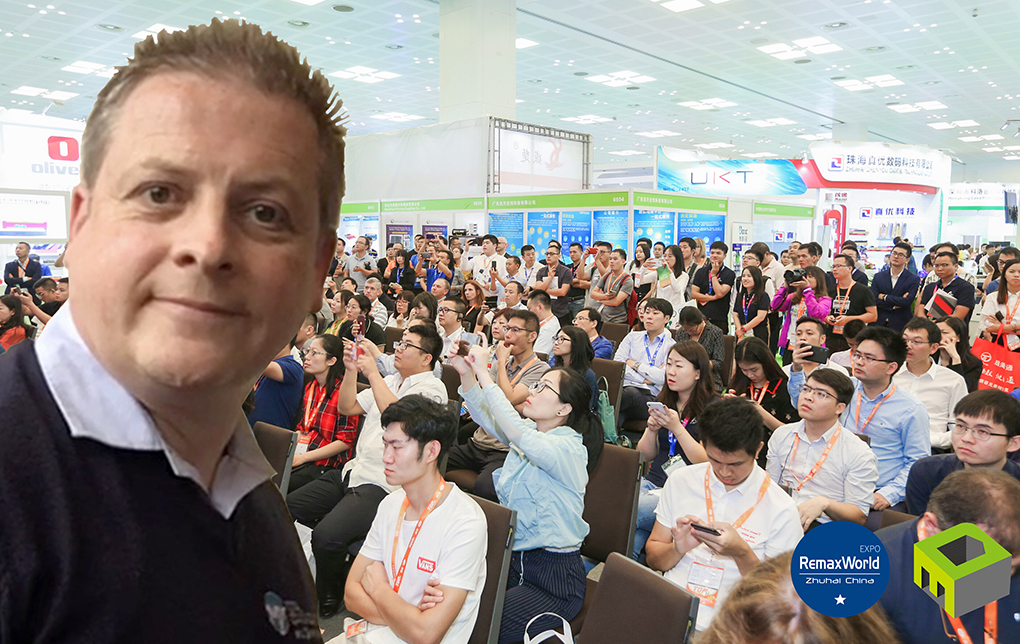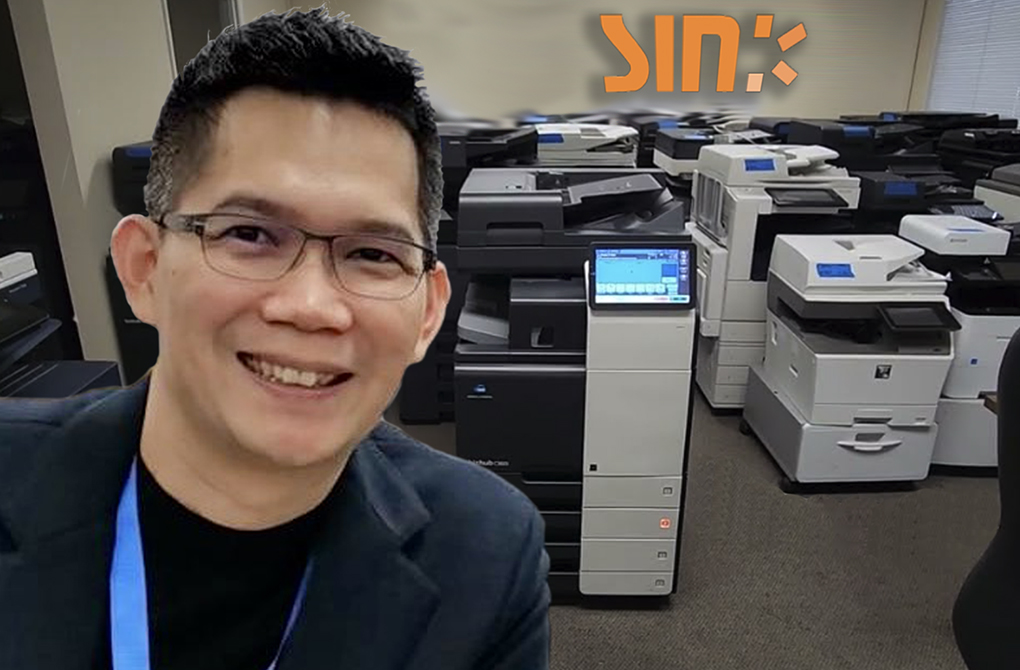My View on the Future of the Print Technology Industry

Darren attends the crowded RemaxWorld Summit in Zhuhai, China
In my view, we’ve got to segment the market into four types of customers, before we start:
- large enterprises
- central and local government
- small and medium enterprises
- self-employed and micro-business (start-ups)
If any of you attended last years RemaxWorld Expo in Zhuhai, you may have caught a talk by John Shane (pictured below), the Keypoint Intelligence Infotrends director of communication supplies consulting service.
 He presented fact-based research showing (even before the global pandemic) a decline in printing by large enterprises across North America and Western Europe.
He presented fact-based research showing (even before the global pandemic) a decline in printing by large enterprises across North America and Western Europe.
Driven by investments in workflow and automation software, to reduce employee costs and improve service, rather than wanting to eradicate print.
Although…
This decline was not mirrored in small and medium enterprises. In fact, if anything they were showing a slight increase in printing-related activities. The theory being these organisations we’re not big enough to benefit (or afford the large investment required) from workflow and automation software in the same way as large enterprises.
Interestingly, other global regions, such as Asia, weren’t yet seeing the same declines in large organisations, but growth was definitely slowing, and it’s thought it’s only a matter of time before the same printing landscape is mirrored in other global regions.
So, what does this mean post-pandemic?
For me. It means four things:
- An acceleration in workflow and automation software investment in large enterprises
- A switch from large A3 office technology to smaller A4 devices in some instances
- Service driven solutions for smaller offices (including home offices)
- A need for flexible agreements and creative payment schemes
My good friend Ray Stasieczko has talked about the death of A3, the need for fixed priced agreements and the convergence of office technologies. Although sometimes controversial, much of what Ray talks about I agree with, and it’s coming true. Although accelerated by the pandemic.
Large enterprises…
We’ve already started to see these organisations reducing workforces. They will increase their investment in workflow software, automation software and online digital platforms for sales and customer support. Which will see a further reduction in employee numbers?
Their mix of employees will change, with many customer-facing roles being removed and replaced with desk-based activities, supported by new systems and software.
The new systems and software will be cloud-based, so their desk-based employees can work remotely, from smaller office clusters or in their own home office. Making large office locations redundant and will be removed, as they are a drain on profits and cash flow.
The office technology need for large enterprises will change (as Ray Stasieczko preaches). No longer will they require technologies to support multiple floors of the head office or regional office teams (although there will still be some requirement). The need will be for smaller printing technologies suitable for smaller or home offices, doing substantially less printing, due to the new systems and software.
Phone systems will need to change too. These remote workers will still be required to be included within the enterprise phone system and operate seamlessly as before. Which can be achieved today with cloud-based technology and mobile phone apps which mimic the central phone system.
For a large enterprise, there will be many more remote locations which require business, supplies and IT support. Suppliers to these enterprises will need to change, and understand support requirements (including deliveries, onsite support, phone support and remote support) are going to increase in numbers and be much more widespread.
Central & local government…
This is an interesting customer profile. Although they could be classed as large enterprises, change in these organisations tends to happen at a much slower pace. Particularly as they’re not under the same cash flow constraints as business and are affected greater by trade unions.
In the short-term, they will have many team members working from home, which will require suppliers to help them support these remote locations, in the same way as large enterprises.
But as restrictions ease, workplace safety measures get installed and (hopefully) a vaccine becomes available. Things (in the short to medium term) will return to some sort of normality and the status quo will resume for a time.
In government, it takes time for new technologies (if it means reducing employees) to be accepted and adopted. So, in the short to medium-term, governments will continue to invest in large A3 devices (as they’re cheaper to run) and support their team members in similar ways as today.
Small & medium enterprises…
The larger of the medium enterprises will act like large enterprises and adopt new software and systems, whilst reducing employee numbers and pushing remaining team members to work remotely. These enterprises will also require support from suppliers in similar ways.
It’s my belief smaller enterprises will have a more hybrid approach, they’re main office sites weren’t that big pre-pandemic, so in many cases not a lot will change.
Except for those small organisations whose team members embraced the remote working and became more productive. They’ll let these team members continue to work from home when it’s convenient for them to do so. But also making sure they come into the office for meetings, debriefs and to use the higher quality and more feature-rich office technology.
These smaller organisations have lower overheads, less need for control, smaller teams, and much smaller budgets than large enterprises. Making it unlikely that they’ll invest anywhere near to the same level in new software and systems. A clear differentiator for these organisations (against large enterprises) will be that they are people-based rather than artificial intelligence-based.
In anything, there will be a small increase in technology and support investment (for their occasional remote workers) with the main office technology and support requirements remaining similar.
Self-employed and Micro Businesses
I think it goes without saying. We are going to see a large increase in self-employed people and start-ups, working from home or in very small workplaces, and this is where the real opportunity lies.
But. You’ve got to understand as a supplier, you’ve got to put yourself in their shoes. They’re starting out in business for the first time, have limited cash flow and no credit history.
Which means your solutions must be designed to address these two core areas, whilst still providing them with fit-for-purpose solutions and the help they require.
The technology and support requirements are simple in my eyes.
Computer (laptop probably) with Microsoft Office, broadband with a cloud phone system or just a mobile app (with the ability to create a virtual office) and an A4 multifunction inkjet printer with or without multiple scan sheet-feeder (depending on need & budget). Wrapped in a lifetime support & maintenance package.
Here’s the kicker though. You’ve got to be able to supply all this (including the replacement cartridges) in one affordable fixed monthly fee, on a rolling monthly agreement, which they can cancel at any-time with any financial penalty.
Add to this. Supplies such as paper, files, pens, highlighters etc in small numbers, at low cost with no minimum order and with fast and free delivery.
The Big Opportunity…
…is in a full solution (including cartridges) for the new breed of self-employed and micro-business start-ups we’re about to witness.

Darren Turner’s imaging business success story began in 2003 when he opened a retail store in the UK selling printer supplies to home users & small organisations. Since then he has moved into a business unit, grown his team and continued to adapt to match his customers’ changing needs. He has developed a ‘fit for purpose’ office products and solutions business model that provides certainty of cost and service for small business, charities and schools—thus providing them complete peace of mind.
He has become a trusted advisor for small organisations across the world. Turner invites you to chat with him about your business, reaching out to him on LinkedIn, email or on the phone +44-7887-548523
Read his other posts and logs:
- My View on the Future of the Print Technology Industry
- Planes Trains and Automobiles (and bicycles)
- Why Procrastinate Today When You Can Put it off Until Tomorrow
- Planting Trees as an Office Solution













Leave a Comment
Want to join the discussion?Feel free to contribute!